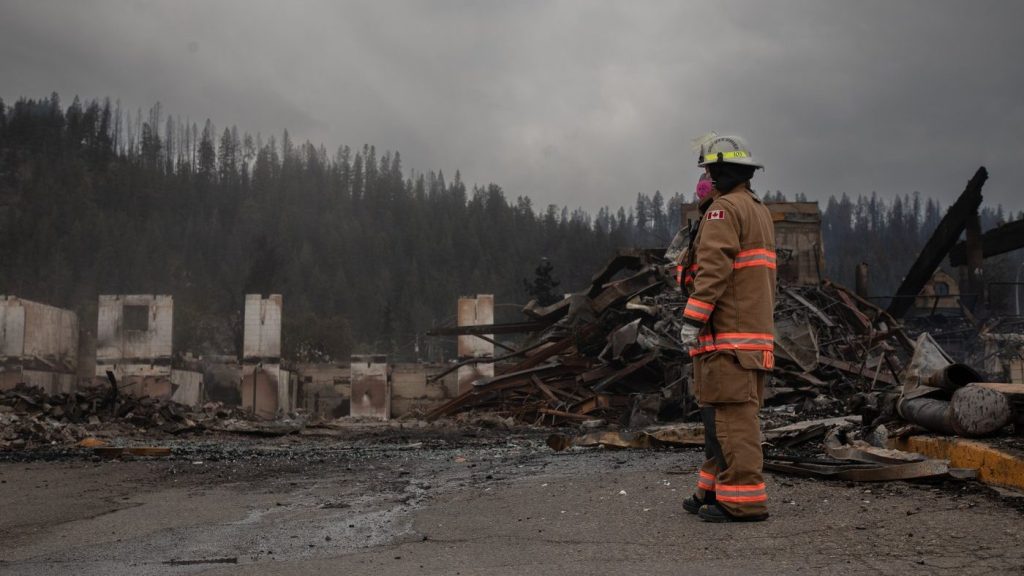No amount of resources, coordination could have stopped Jasper wildfire: officials

Posted July 29, 2024 12:39 pm.
Last Updated July 30, 2024 9:51 am.
Conventional firefighting tools were simply no match for a destructive “raging inferno” that raced toward Jasper last week, ultimately destroying a large portion of the town, officials are now saying.
“There is nothing any human on Earth or any piece of equipment could have done standing in front of that wall of fire that would have allowed them to stop it. It’s just not possible,” said Ron Hallman, president and CEO of Parks Canada.
The situation on the ground is stabilizing, Parks Canada says. All blazes within the community are now out. Crews are working to get power back in town and checking the integrity of critical infrastructure.
Officials are planning for a staged re-entry of evacuees, but there is no firm timeline.
“Conditions are not safe within the community to allow access in terms of incident stabilization, in terms of all the work being done to deal with damage within the community,” said Landon Shepherd, incident commander with Parks Canada.
All orders of government are meeting to talk about rebuilding and temporary housing, Hallman confirmed. He said there’s federal and provincial money available to help get it done.
But there’s also an ongoing wildfire threat, with increased fire behaviour expected in the coming days.
Some 25,000 people in and around the community nestled in the Rocky Mountains four hours west of Edmonton were ordered to evacuate last Monday due to wildfires threatening from the north and south.
Parks Canada says the fast-moving blaze that destroyed 358 structures in Jasper – 30 per cent of the town – burned an estimated 15 feet a minute. Towering flames reached 100 metres above the tree line. Burning pinecones and debris were projected a kilometre ahead.
Federal Environment Minister Steven Guilbeault says the wildfire devastation in the tourist town — within what became a national park in 1930 — was not due to a lack of planning, coordination or resources. He says no request for assistance went unmet.
“To think that over all those decades we would not have deployed all of the resources necessary to try and do everything that is humanly possible to protect a town from a forest fire is simply not true,” Guilbeault said.
In fact, officials are claiming preventative efforts – prescribed burns; mechanical removal of hazardous trees and underbrush; sprinkler systems in key areas; and interagency emergency scenario trainings – allowed them to save the town from further destruction.
Those actions “have significantly mitigated what may otherwise have been an even more devastating fire,” Hallman said.
“The fact that we were able to protect 70 per cent of the town speaks to all of those measures we have put in place over the years and frankly, decades,” added Guilbeault.
Parks Canada says it considered itself prepared for a potential wildfire threat coming from the south of town.
“I would have told you a month ago that that’s an area where we had some of the most work done to prepare for the potential challenges of a large and difficult to control wildfire,” Shepherd said.
The mayor of Jasper, who lost his family home to the flames, called the fire effort a success story considering all that’s still standing.
“That does not diminish in the least the horrifying experience that those on the ground felt and those residents that return to a devastated community are going to feel,” Richard Ireland said.
Pine beetle infestation
Critics have said more should have been done to thin out forests thick with highly flammable dead trees, especially those killed by mountain pine beetle infestation.
Parks Canada says it began prescribed burns in Jasper in 1995. Work to “FireSmart” Jasper began in 2003, with officials calling the Alberta tourist town one of the first such communities in Canada.
“It’s now a national program for which Jasper was one of the inspirations,” Guilbeault said. “What we do around the country to protect towns and cities from forest fires was inspired largely by what we’ve been doing in Jasper for all these years.”
Hallman adds hundreds of square kilometres of forest was affected by beetle kills and that it simply wasn’t possible to remove them all.
–With files from Sean Amato and The Canadian Press












